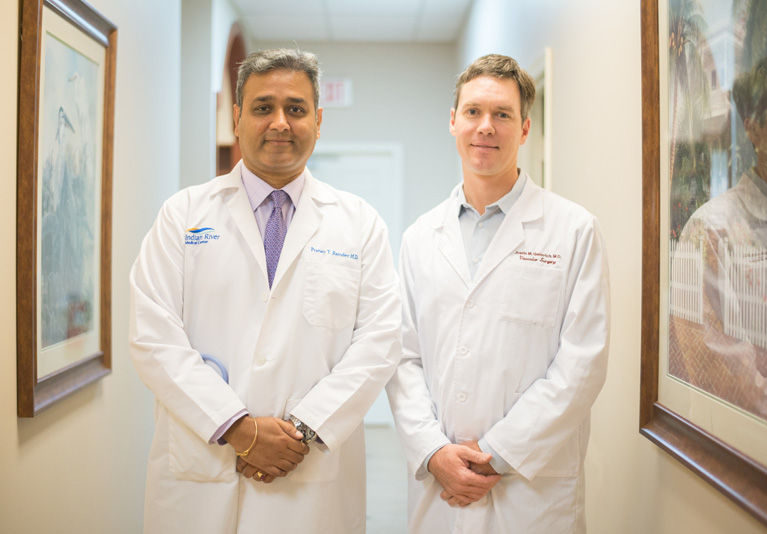
In the continuing battle against peripheral artery disease or PAD, two local vascular surgeons are coming at the problem from a totally different direction. Literally. They’re attacking the disease one “foot” at a time with a new procedure called, “retrograde pedal artery access.”
Instead of going north-to-south, head-to-toe or groin-to-calf in order to clear obstructions in the arteries, Drs. Pranay Ramdev and Justin Galovich Indian River Medical Center are employing a radically new procedure by entering the circulatory system through the foot.
“When I was in training,” explains the Dartmouth and Harvard-educated Ramdev with a smile, “going through the foot was almost heresy” but now he claims this new technique is winning fans both in and outside the vascular surgery world.
PAD is the narrowing or “occlusion” of arteries caused by the accumulation of plaque on the interior walls. It is most commonly seen in the legs, thighs and pelvis and, if left untreated, it can lead to moderate to severe pain, non-healing wounds and even the loss of the affected limb. PAD can also be a sign of more widespread plaque accumulation throughout the arterial system (atherosclerosis) that can lead to heart attack or stroke.
Unfortunately, according to Ramdev, PAD is all too often ignored. Many people mistakenly believe the symptoms of this disease are just another sign of getting old. That thought really riles Ramdev. “Don’t assume,” he pleads, “if you have pain in your legs that it’s just old age. It could be PAD and we can cure that.”
The American Heart Association, along with Ramdev and Galovich, point to cigarette smoking as one of the main risk factors for PAD. The disease is also more likely to affect those over 60 years of age and is especially likely to strike those with diabetes, high cholesterol or high blood pressure.
While Ramdev says he has been using this new pedal approach, “less than a year,” he clearly has embraced the procedure. He says 70 to 75 percent of the endovascular leg work he does nowadays is with this new approach that was only approved by Medicare about 18 months ago.
“The treatment – forever – for any kind of arterial blockage used to be a bypass,” explains Ramdev. “That was it. There was no other option. Now there are a myriad of options” including this particular endovascular technique of inserting a tiny tube containing miniature tools into an artery in the foot, eliminating the need for long incisions into the skin that require far more extensive healing time than the new procedure.
The Harvard-trained surgeon points to two more factors he likes about the foot-first approach. First, he explains, many arterial blockages, when approached in an “antigrade” fashion, or from heart-to-foot, can be difficult, if not impossible, to remove but when approached in a “retrograde” or foot-to-heart direction, those same blockages can often be cleared far more easily.
Second, Ramdev points to the speed of recovery. “Patients come into the hospital and go home the same day,” he says. In fact, “within three hours, most patients are up and moving around well.”
Perhaps not surprisingly, Ramdev and Galovich have adopted yet another new philosophy: They don’t like stents. Stents are those metallic mesh tubes that have for years been inserted into arteries in an attempt to keep the blood vessels open but often ended up causing almost as many problems as they solved. “We really try,” Ramdev says, “not to use them.”
Meanwhile, if Ramdev’s enthusiasm is apparent, so too is Dr. Galovich’s. He arrived here in Vero Beach in August after completing his internship and residency at UCLA and was never burdened by the idea that approaching arterial blockages or occlusions through the foot is a type of “heresy.” In fact, like most younger physicians and surgeons, Galovich has spent his entire career immersed in all the newest techniques available.
The West Coast transplant also points to the new tools available to surgeons like himself and Ramdev as one of many reasons the pedal approach works so well. They have, says Galovich, “much greater flexibility and sharper blades and are less likely to damage the artery.”
A further benefit, according to the National Library of Medicine at the National Institutes of Health, is that patients are generally only sedated enough to relax them in order to minimize their foot movement during the procedure.
“Although retrograde pedal artery access is a relatively new technique,” says NIH, “it is a promising alternative for patients in whom conventional techniques failed to achieve the opening or ‘re-canalization’ of the affected arteries.”
NIH goes on to say, “this approach has a high technical success rate and a relatively low procedural complication rate” reinforcing Ramdev’s and Galovich’s assertion that it is an attractive, modern and minimally invasive option in the fight against PAD.
And, once again, Ramdev urges anyone with even the slightest symptoms of PAD not to chalk up that pain in their legs or calves to an inevitable sign of aging. Instead he forcefully repeats his earlier statement that such symptoms could very well be signs of PAD and once again flatly re-states, “We can cure that.”
Dr. Pranay Ramdev and Dr. Justin Galovich are with Vascular Interventional and Vein Associates. Their Vero office has moved to 960 37th Place, Suite 104. Both doctors have affiliations with the Indian River Medical Center and the Sebastian River Medical Center. The phone number is 772-567-8482 in Vero and 772-646-4626 in Sebastian. The website is www.vivamyveins.com.



